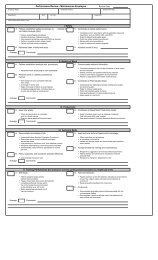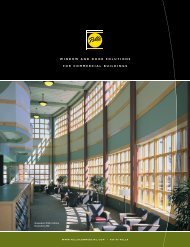Building Operating Management September 2011 - FacilitiesNet
Building Operating Management September 2011 - FacilitiesNet
Building Operating Management September 2011 - FacilitiesNet
Create successful ePaper yourself
Turn your PDF publications into a flip-book with our unique Google optimized e-Paper software.
92<br />
buildingoperatingmanagement<br />
SEPTEMBER <strong>2011</strong><br />
SHOWCASE: HVAC<br />
Know What to Look for<br />
When Upgrading HVAC<br />
by casey laughman, managing editor<br />
Upgrading an HVAC system represents<br />
a major investment of time<br />
and money, so it’s not something to enter<br />
into without proper planning. What<br />
that plan involves isn’t always clear at<br />
the beginning. Just as every building is<br />
different, so is every HVAC system. And<br />
while replacing one piece may work out<br />
just fine, it also could simply be the first<br />
in a series of dominoes.<br />
“It may be that you replace a component<br />
and it will make it even more<br />
inefficient than it was before. You have<br />
to look at the whole system and look<br />
at what really needs to be done for the<br />
money to give you the best return on<br />
your investment,” says Jon Cogdill, senior<br />
property manager, Hines.<br />
Cogdill, and other experts agree on<br />
one point: While there’s no such thing<br />
as a standard HVAC upgrade, there<br />
are some aspects of the process that<br />
always apply.<br />
Begin at the Beginning<br />
If you’re looking into upgrading<br />
your HVAC system because equipment<br />
is reaching the end of its life or because<br />
the building needs better service, it can<br />
be an easier sell than simply looking to<br />
become more energy efficient.<br />
“Are you trying to solve a problem?<br />
Or are you trying to make it more efficient?”<br />
says Clayton Ulrich, senior<br />
vice president, engineering services,<br />
Hines. “It’s clearly very hard to justify<br />
what we would loosely call an HVAC<br />
upgrade in an existing building if there<br />
isn’t a problem.”<br />
If you can combine efficiency with<br />
another compelling reason to replace<br />
part or all of an HVAC system, it becomes<br />
a much easier sell. A big part of<br />
that sell, however, is knowing exactly<br />
what you need.<br />
Say you’re replacing a chiller. Because<br />
chillers can easily last 30 years or<br />
more, the odds are good that the needs<br />
of the building and its occupants have<br />
changed since it was installed.<br />
“The first thing is to consider the<br />
asset you’re talking about,” says Tony<br />
Bamonte, vice president and regional<br />
property manager, Liberty Property<br />
Trust. “I don’t suggest you just replace<br />
units with a like kind.”<br />
Cogdill says he can attest to that<br />
from personal experience. Hines has<br />
been working on an HVAC upgrade<br />
of Two Shell Plaza in Houston, a more<br />
d<br />
a<br />
b<br />
c<br />
❯❯a. AIRXCHANGE fi eld-assembled energy recovery wheel<br />
cassettes are cut into halves or quarters and marked for reassembly<br />
to fi t through standard doorways and allow for installation<br />
in limited-access areas. Wheels recycle up to 80 percent of heating<br />
and cooling energy contained in exhaust air. Wheel segments can<br />
be removed for cleaning. AIRXCHANGE: CIRCLE #255<br />
❯❯b. FRIEDRICH packaged terminal air conditioner features<br />
indoor and outdoor motors, three-speed fan and universal heater/<br />
power cord. Tangential blower wheel has surface area almost<br />
fi ve times larger than previous fans. Fits standard 42-inch sleeves<br />
without baffl e kit. Separate heating and cooling limits. Unit supports<br />
centralized desk control and is compatible with energy management<br />
systems. FRIEDRICH: CIRCLE #227<br />
❯❯c. GREENHECK rooftop ventilation unit conditions and<br />
controls any mixture of outdoor and return air. The unit has 2-inch<br />
double-wall construction and direct-drive plenum fans. Indirect gas<br />
furnace, hot water or electric heating options; packaged or split<br />
direct-expansion or chilled water cooling options. Optional energy<br />
wheel. Capacity up to 9,500 cfm. GREENHECK: CIRCLE #228<br />
❯❯d. AEGIS SGR protection ring channels electrical current<br />
away from motor bearings. Available in standard sizes to fi t AC<br />
motors from 1 to 1,500 HP with shaft diameters from 8 mm to 153<br />
mm. Larger sizes are available for shafts with greater than 6-inch<br />
diameter. Screw-on mounting brackets require no machining.<br />
AEGIS: CIRCLE #229





